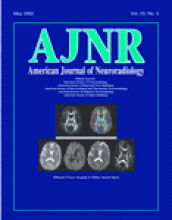Research ArticleBrain
Diffusion Anisotropy in the Corpus Callosum
Neeraj B. Chepuri, Yi-Fen Yen, Jonathan H. Burdette, Hong Li, Dixon M. Moody and Joseph A. Maldjian
American Journal of Neuroradiology May 2002, 23 (5) 803-808;
Neeraj B. Chepuri
Yi-Fen Yen
Jonathan H. Burdette
Hong Li
Dixon M. Moody

References
- ↵Biegon A, Eberling JL, Richardson BC, et al. Human corpus callosum in aging and Alzheimer’s disease: a magnetic resonance imaging study. Neurobiol Aging 1994;15:393–397
- ↵Cumming WJ. An anatomical review of the corpus callosum. Cortex 1970;6:1–18
- ↵Cowley AR. Dyke award: influence of fiber tracts on the CT appearance of cerebral edema—anatomic-pathologic correlation. AJNR Am J Neuroradiol 1983;4:915–925
- ↵Rakic P, Yakovlev PI. Development of the corpus callosum and cavum septi in man. J Comp Neurol 1968;132:45–72
- ↵Parashos IA, Wilkinson WE, Coffey CE. Magnetic resonance imaging of the corpus callosum: predictors of size in normal adults. J Neuropsychiatry Clin Neurosci 1995;7:35–41
- ↵Doraiswamy PM, Figiel GS, Husain MM, et al. Aging of the human corpus callosum: magnetic resonance imaging in normal volunteers. J Neuropsychiatry Clin Neurosci 1991;3:392–397
- ↵Rajapakse JC, Giedd JN, Rumsey JM, et al. Regional MRI measurements of the corpus callosum: a methodological and developmental study. Brain Dev 1996;18:379–388
- ↵Barkovich AJ, Kjos BO. Normal postnatal development of the corpus callosum as demonstrated by MR imaging. AJNR Am J Neuroradiol 1988;9:487–491
- ↵Ferrario VF, Sforza C, Serrao G, Frattini T, Del Favero C. Shape of the human corpus callosum. Elliptic Fourier analysis on midsagittal magnetic resonance scans. Invest Radiol 1994;29:677–681
- ↵Hayakawa K, Konishi Y, Matsuda T, et al. Development and aging of brain midline structures: assessment with MR imaging. Radiology 1989;172:171–177
- ↵Moody DM, Bell MA, Challa VR. The corpus callosum, a unique white-matter tract: anatomic features that may explain sparing in Binswanger disease and resistance to flow of fluid masses. AJNR Am J Neuroradiol 1988;9:1051–1059
- ↵Melhem ER, Itoh R, Jones L, Barker PB. Diffusion tensor MR imaging of the brain: effect of diffusion weighting on trace and anisotropy measurements. AJNR Am J Neuroradiol 2000;21:1813–1820
- ↵Pierpaoli C, Basser PJ. Toward a quantitative assessment of diffusion anisotropy. Magn Reson Med 1996;36:893–906
- ↵Wimberger DM, Roberts TP, Barkovich AJ, et al. Identification of “premyelination” by diffusion-weighted MRI. J Comput Assist Tomogr 1995;19:28–33
- ↵Assaf Y, Ben-Bashat D, Chapman J, et al. High b-value q-space analyzed diffusion-weighted MRI: Application to multiple sclerosis. Magn Reson Med 2002;47:115–126
- ↵Basser PJ, Pierpaoli C. Microstructural and physiological features of tissues elucidated by quantitative-diffusion-tensor MRI. J Magn Reson B 1996;111:209–219
- ↵Guo AC, Jewells VL, Provenzale JM. Analysis of normal-appearing white matter in multiple sclerosis: comparison of diffusion tensor MR imaging and magnetization transfer imaging. AJNR Am J Neuroradiol 2001;22:1893–1900
- ↵Bozzali M, Franceschi M, Falini A, et al. Quantification of tissue damage in AD using diffusion tensor and magnetization transfer MRI. Neurology 2001;57:1135–1137
- ↵O’Sullivan M, Summers PE, Jones DK, et al. Normal-appearing white matter in ischemic leukoaraiosis: a diffusion tensor MRI study. Neurology 2001;57:2307–2310
In this issue
Advertisement
Neeraj B. Chepuri, Yi-Fen Yen, Jonathan H. Burdette, Hong Li, Dixon M. Moody, Joseph A. Maldjian
Diffusion Anisotropy in the Corpus Callosum
American Journal of Neuroradiology May 2002, 23 (5) 803-808;
0 Responses
Jump to section
Related Articles
- No related articles found.
Cited By...
- Altered White Matter Tracts in Bipolar Disorder: Insights from DTI Analysis
- Unifying Orientation-Dependent Relaxation and Diffusion Around Axonal Fibers from DTI: Characterizing Fiber-Tract-Specific Anisotropic R2 Profiles of the Corpus Callosum
- Diffusion Measures Indicate Fight Exposure-Related Damage to Cerebral White Matter in Boxers and Mixed Martial Arts Fighters
- Microstructural organization of corpus callosum projections to prefrontal cortex predicts bimanual motor learning
- Diffusion Tensor Group Tractography of the Corpus Callosum in Clinically Isolated Syndrome
- Callosal Contributions to Simultaneous Bimanual Finger Movements
- Structural Organization of the Corpus Callosum Predicts the Extent and Impact of Cortical Activity in the Nondominant Hemisphere
- Neuroradiological characterization of normal adult ageing
- Diffusion Tensor MR Imaging Visualizes the Altered Hemispheric Fiber Connection in Callosal Dysgenesis
This article has not yet been cited by articles in journals that are participating in Crossref Cited-by Linking.
More in this TOC Section
Similar Articles
Advertisement











